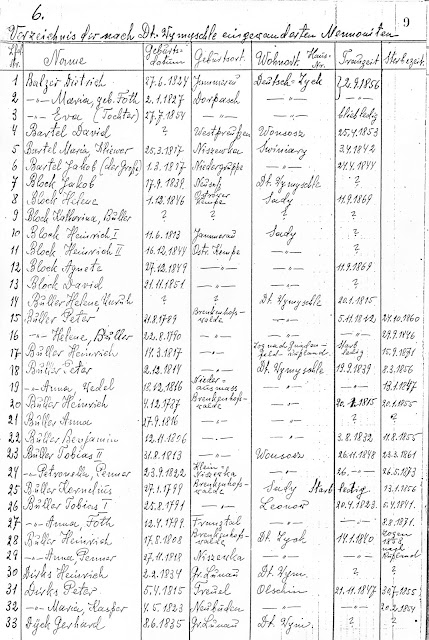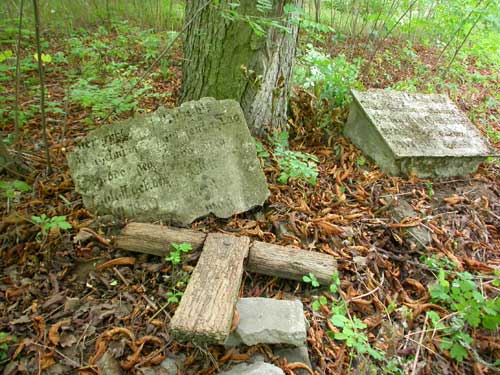Foth’s history of the church seems to incorporate material from the original church records, listing dates of birth, baptism, marriage, and death, as well as villages of birth and of residence and other information of genealogical interest. However, the information is not presented in a running list, as we have seen with the Przechowka church book. Rather, Foth’s history intersperses archival records with his story of the church’s history: he offers both data and interpretation.
Interesting as his narrative may be (e.g., he tells of the church’s experience of World War II from an apparently firsthand perspective), it is the records that are of most interest to us, so that is where our attention will be directed. Foth arranges these records in various forms, for example, a register of the Mennonites who moved to Deutsch-Wymysle from West Prussia and Neumark or a different list of Mennonites who left Deutsch-Wymysle for some other country (e.g., Russia, the United States).
Each list deserves its own examination, so we begin with the first list in the book: Verzeichnis der nach Dt. Wymyschle eingewanderten Mennoniten aus Westpreußen und der Neumark (List of Mennonites Who Moved to Deutsch-Wymysle from West Prussia and Neumark). Seven pages list 234 persons in alphabetical order by last name (e.g., all the Balzers, followed by the Bartels, Blocks, Bullers, and so on).
 |
| Foth’s History of the Mennonites of Deutsch-Wymysle, Poland, page 9. |
We will make observations about the entire list a little later; for now our interest is with the Bullers in the church. Which Bullers moved to the Deutsch-Wymysle vicinity and joined the church there? The closeup of the scan below will provide all the answers.
Numbers 14–29 are Bullers either by birth or by marriage, sixteen in all (i.e., 6.8 percent of the 234 people listed). Since our interest is in Bullers by birth, we should exclude the five women who were Bullers by marriage: numbers 14, 19, 24, 27, and 29. This takes us down to eleven Bullers.
On the other hand, the list also contains six women who were born Buller but are now listed under a husband’s last name: (9) Katharina Buller Block, (93) Susanna Buller Kliewer, (126) Helene Buller Nachtigall, (127) Eva Buller Nachtigall (Helene and Eva were married to the same man), (162) Helene Buller Ratzlaff, and (209) Susanna Buller Unruh. This increases our total to seventeen Bullers by birth who moved to the church at Deutsch-Wymysle.
What can we observe about them?
1. The birth years recorded stretch from 1787 through 1817: 1787, 1789, 1790, 1781, 1799, 1805, 1806, 1808, 1809, 1813, 1814, 1815, 1816 (two), 1817, and two unknown. It would not be surprising if the four born earliest were parents of most or even all of the six born last (from 1813 on).
2. The place of birth is not known for two Bullers (9 and 162). Of the remaining fifteen, thirteen are said to have been born in Brenkenhoffswalde, the Mennonite village in the Neumark that captured our attention for a number of posts. The remaining two (126 and 127) were born in Ostrower Kämpe, a small village near the Przechowka church (F in the map here). Thus, until other evidence indicates otherwise, we can assume that the majority of the Bullers in the Deutsch-Wymysle church came from the Neumark village of Brenkenhoffswalde.
3. The primary village of residence is unknown for the same two Bullers (9 and 162) whose place of birth was unknown. Most of the remaining Bullers lived in Deutsch-Wymysle itself: 15, 16, 18, 20, 21, 22, 28, 93, and 209. However, some lived in one of the other small villages nearby: Wonsosz, Sady, Leonow, and Deutsch Zyck. What united them was their membership in the same Mennonite church, which was located in Deutsch-Wymysle.
 |
| Fragment of a wooden cross in the Deutsch-Wymysle cemetery. Photograph by Jutta Dennerlein, 2005 (here). |
5. Speaking of dates of death, they range from 1838 (Helene Buller Nachtigall 126, who died at the age of twenty-nine) through 1871 (Heinrich 17 in Gnadenfeld): 1838, 1841, 1846, 1855 (two), 1856 (two), 1860, 1861, 1871, and four unknown.
6. It is easy enough to identify married couples (they share the same date of marriage): 15 + 16, 18 + 19, 23 + 24, 26 + 27, and 28 + 29. Two Bullers are listed as never married: Heinrich 17 and Kornelius 25; in both cases the marriage slot contains the note that they died unmarried (starb ledig). Finally, one wonders if Heinrich 20 has a marriage date listed but no spouse because his wife passed away before he moved from Brenkenhoffswalde to Deutsch-Wymysle. This explanation does not work for Benjamin 22 (he was married after leaving Brenkenshoffswalde), so his listing of a marriage date but no spouse must remain a mystery for the present.
We seemed to have mined this vein as completely as we can for the time being, so the next post or two will draw some conclusions from this data for our developing history of the larger Buller family, as well as for our understanding of the Deutsch-Wymysle church in general.
Works Cited
The Cemetery of Nowe Wymyśle. Page in the UpstreamVistula.org website. For additional pictures, background information, and further bibliography, see here.
Foth, Robert. 1968. Aufzeichnungen über das Leben der Mennoniten- und MB-Gemeinde zu Wymyschle, Polen. Mennonitische Rundschau 29 May.


No comments:
Post a Comment